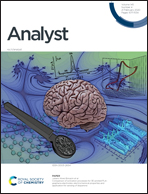Rapid and sensitive detection of drugs of abuse in sweat by multiplexed capillary based immuno-biosensors†
Abstract
Rapid and sensitive detection of drugs of abuse plays an important role in monitoring of drug use and treatment compliance. Sweat based drug analysis shows great advantages due to its non-invasive nature. However, most of the related methods developed to date are qualitative, slow, or costly, which significantly hinders their application in field use. Here we report rapid, sensitive, quantitative detection of drugs of abuse in sweat based on capillary arrays combined with competitive enzyme-linked immunosorbent assay. Using four common drugs of abuse, methadone, methamphetamine, amphetamine, and tetrahydrocannabinol, spiked in artificial sweat as a model system, we demonstrate rapid, quantitative, and multiplexed detection of the four drugs in ∼16 minutes with a low sweat volume (∼4 μL per analyte) and a large dynamic range (methadone: 0.0016 ng mL−1–1 ng mL−1; METH: 0.016 ng mL−1–25 ng mL−1; amphetamine: 0.005 ng mL−1–10 ng mL−1; THC: 0.02 ng mL−1–1000 ng mL−1). In addition, we show that the detection range can be tuned for different applications by adjusting the competitors’ concentrations. Our work paves a way to develop an autonomous, portable, and cost-effective device for hospital testing, workplace drug-use screening, roadside testing, and patient monitoring in drug rehabilitation centers.



 Please wait while we load your content...
Please wait while we load your content...